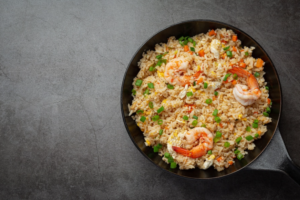The internet recently buzzed with talk of fried rice syndrome sparked by a TikTok video that resurfaced a tragic case from 2008. But what exactly is it? This peculiar term points to food poisoning caused by Bacillus cereus, a sneaky bacterium that poses a threat when cooked food is left out at room temperature for too long.

Meet Bacillus Cereus
Bacillus cereus is a ubiquitous bacterium found throughout the environment. It becomes problematic when it infiltrates specific cook foods that are store improperly. While it’s commonly associate with starchy dishes like rice and pasta, it can also meddle with other cook items, including vegetables and meat.
The Trickster Toxins
Here’s where B. cereus stands out. It possesses a unique ability that sets it apart from other bacteria: the production of spores, which are incredibly heat-resistant. While heating leftovers to high temperatures can eliminate most bacteria, B. cereus might persist if it’s lurking in your food.
These spores remain dormant, waiting for the right conditions. When the time is ripe, they activate and start churning out toxins that lead to illness.
Spotting the Symptoms
Infections cause by B. cereus typically manifest as diarrhea and vomiting. Interestingly, there are two types of B. cereus infections—one link to diarrhea and the other to vomiting. Most cases resolve within a few days, but vulnerable individuals, like children or those with underlying health issues, might require medical attention.
Preventing “Fried Rice Syndrome”
To steer clear of “fried rice syndrome” and other B. cereus-relate woes, follow this simple rule: keep leftovers hot when they should be hot and cold when they should be cold. The key is to minimize the time they spend in the danger zone, where toxins can flourish. This danger zone falls between your fridge’s temperature and 60°C (140°F), which is the ideal reheating temperature.
After cooking a meal, if you plan to enjoy it over the next few days, don’t wait for it to cool down—refrigerate it right away. If possible, divide large portions into smaller ones because it takes time for the cold to penetrate a large batch of food. This also reduces the number of times you open the fridge, which is a win-win.
Conclusion
As a general guideline, adhere to the 2-hour/4-hour rule. If food has out of the fridge for up to 2 hours, it’s safe to return it. Beyond that, it’s eat or toss. After 4 hours, it starts to pose a risk, so it’s better to err on the side of caution and discard it.
Lastly, remember the age-old food safety adage: when in doubt, throw it out. And don’t forget the basics of food hygiene—wash your hands before cooking, use clean utensils, and prevent cross-contamination between cook and raw foods.
In a nutshell, if you want to dodge “fried rice syndrome” and keep your stomach happy, maintain the appropriate temperature for your food and uphold good food hygiene practices.
